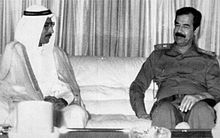Republic of Kuwait جمهورية الكويت Jumhūrīyat al-Kuwait | |||||||||||
|---|---|---|---|---|---|---|---|---|---|---|---|
| 1990 | |||||||||||
 | |||||||||||
| Status | Puppet state of Iraq | ||||||||||
| Capital | Kuwait City | ||||||||||
| Common languages | Arabic | ||||||||||
| Government | Unitary provisional Ba'athist republic | ||||||||||
| Prime Minister | |||||||||||
• 1990 | Alaa Hussein Ali | ||||||||||
| Historical era | Gulf War | ||||||||||
| 4 August 1990 | |||||||||||
• Transformed into Governorate | 28 August 1990 | ||||||||||
| ISO 3166 code | KW | ||||||||||
| |||||||||||

The Republic of Kuwait was a short-lived and self-styled republic formed in the aftermath of the invasion of Kuwait by Ba'athist Iraq during the early stages of the Gulf War. During the invasion, the Iraqi Revolutionary Command Council stated that it had sent troops into the State of Kuwait to assist an internal coup d'état initiated by "Kuwaiti revolutionaries."[1] A Provisional Government of Free Kuwait was set up on 4 August 1990 by the Iraqi authorities under the leadership of nine allegedly-Kuwaiti military officers (four colonels and five majors) led by Alaa Hussein Ali, who was given the posts of prime minister (Rais al-Wuzara), commander-in-chief, minister of defense and minister of the interior.[2]
The new regime deposed the Emir Jaber Al-Ahmad Al-Jaber Al-Sabah (who fled Kuwait and established a government in exile based in Saudi Arabia[3]) and accused the emiri family of pursuing anti-popular, anti-democratic, pro-imperialist, and Zionist policies along with the "embezzlement of national resources for the purpose of personal enrichment".[4] An indigenous Popular Army to allegedly take over from Iraqi troops was immediately proclaimed, claiming 100,000 volunteers.[5]
Citizenship rights were conferred to non-Kuwaiti Arabs who had come for work from abroad under the monarch[6] The newspaper of the regime was known as Al-Nida,[7] named after the "Day of the Call" that was proclaimed on 2 August 1990 to "commemorate" the Iraqi "response" to the alleged calls of the Kuwaitis for Iraq's assistance in overthrowing the monarchy.[8]
- ^ Clive H. Schofield & Richard N. Schofield (Ed.). The Middle East and North Africa. New York: Routledge. 1994. p. 147.
- ^ Newsweek Vol. 116. 1990. p. 20.
- ^ Michael S. Casey. The History of Kuwait. Westport, CT: Greenwood Press. 2007. p. 93.
- ^ Daily Report: Soviet Union. Issues 147-153. 1990. p. 124.
- ^ Jerry Mark Long. Saddam's War of Words: Politics, Religion, and the Iraqi Invasion of Kuwait. Austin, TX: University of Texas Press. 2004. p. 27.
- ^ Dilip Hiro. Desert Shield to Desert Storm: The Second Gulf War. Lincoln, NE: iUniverse, Inc. 2003. p. 105.
- ^ Human Rights Watch World Report 1992: Events of 1991. New York: Human Rights Watch. 1991. p. 652.
- ^ Itamar Rabinovich and Haim Shaked (Ed.). Middle East Contemporary Survey Vol. 14. Oxford: Westview Press. 1990. p. 403.

